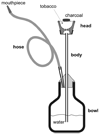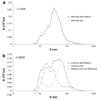Comparison of carcinogen, carbon monoxide, and ultrafine particle emissions from narghile waterpipe and cigarette smoking: Sidestream smoke measurements and assessment of second-hand smoke emission factors
- PMID: 20161525
- PMCID: PMC2801144
- DOI: 10.1016/j.atmosenv.2009.10.004
Comparison of carcinogen, carbon monoxide, and ultrafine particle emissions from narghile waterpipe and cigarette smoking: Sidestream smoke measurements and assessment of second-hand smoke emission factors
Abstract
The lack of scientific evidence on the constituents, properties, and health effects of second-hand waterpipe smoke has fueled controversy over whether public smoking bans should include the waterpipe. The purpose of this study was to investigate and compare emissions of ultrafine particles (UFP, <100 nm), carcinogenic polyaromatic hydrocarbons (PAH), volatile aldehydes, and carbon monoxide (CO) for cigarettes and narghile (shisha, hookah) waterpipes. These smoke constituents are associated with a variety of cancers, and heart and pulmonary diseases, and span the volatility range found in tobacco smoke.Sidestream cigarette and waterpipe smoke was captured and aged in a 1 m(3) Teflon-coated chamber operating at 1.5 air changes per hour (ACH). The chamber was characterized for particle mass and number surface deposition rates. UFP and CO concentrations were measured online using a fast particle spectrometer (TSI 3090 Engine Exhaust Particle Sizer), and an indoor air quality monitor. Particulate PAH and gaseous volatile aldehydes were captured on glass fiber filters and DNPH-coated SPE cartridges, respectively, and analyzed off-line using GC-MS and HPLC-MS. PAH compounds quantified were the 5- and 6-ring compounds of the EPA priority list. Measured aldehydes consisted of formaldehyde, acetaldehyde, acrolein, methacrolein, and propionaldehyde.We found that a single waterpipe use session emits in the sidestream smoke approximately four times the carcinogenic PAH, four times the volatile aldehydes, and 30 times the CO of a single cigarette. Accounting for exhaled mainstream smoke, and given a habitual smoker smoking rate of 2 cigarettes per hour, during a typical one-hour waterpipe use session a waterpipe smoker likely generates ambient carcinogens and toxicants equivalent to 2-10 cigarette smokers, depending on the compound in question. There is therefore good reason to include waterpipe tobacco smoking in public smoking bans.
Figures





References
-
- Australian National Health and Medical Research Council. Effects of Passive Smoking on Health. Report of the NHMRC Working Party on the Effects of Passive Smoking on Health. Canberra: Australia Government Publishing Service; 1987.
-
- Baek SO, Jenkins RA. Characterization of trace organic compounds associated with aged and diluted sidestream tobacco smoke in a controlled atmosphere – volatile organic compounds and polycyclic aromatic hydrocarbons. Atmospheric Environment. 2004;38:6583–6599.
-
- Baska T, Pudule I, Tilgale N, Warren CW, Lee J, Lea V, Jones NR. Smoking tobacco in waterpipes among adolescents in Europe: the case of Latvia and Slovakia. Tobacco Control. 2008;17:432. - PubMed
-
- Baker R, Dixon M. The retention of tobacco smoke constituents in the human respiratory tract. Inhalation Toxicology. 2006;17:255–294. - PubMed
Grants and funding
LinkOut - more resources
Full Text Sources
Medical
Research Materials
Miscellaneous
